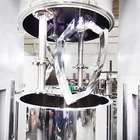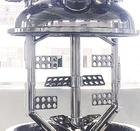Integrating development, manufacturing and sales, as a first-level mixer emulsifier factory.
Top 5 Mistakes to Avoid When Buying a Filling Machine: Technical Mistakes
There are many types of filling machines, each designed to meet specific needs depending on the product and the industry. Choosing the right one can feel overwhelming because of all the available options. But once you clearly define your needs, the decision becomes much easier. Still, even when you know what you're looking for, it's easy to make mistakes that can affect your production in the long run.
In this article, we’ll walk you through some of the most common technical mistakes people make when buying a filling machine. These points are explained in a simple and practical way, to help you avoid costly errors. If you need more detailed advice or have specific questions, feel free to reach out to us by email or WhatsApp.
What to Watch Out For
These errors are the most frequent, especially for first-time buyers. Fortunately, they’re also the easiest to prevent—starting with one key decision:
Choosing the Wrong Type of Filling Machine
This might seem like a basic step, but it's often where things go wrong. Picking the wrong type of filler can lead to issues that affect everything—from the quality of the fill to the lifespan of the machine.
The first thing you need to understand is the nature of your product, and one of the most important factors is:
What is the viscosity of my product?
Viscosity refers to how thick or thin your product is. This characteristic directly affects how fast it flows and which machine can handle it best.
- Thin liquids (like water or juice) flow easily and need lighter filling systems, such as gravity fillers.
- Thicker products (like sauces, creams, or honey) require more force to move and are better suited for piston fillers or servo machines, which push the product into containers in a controlled way.
Using a machine that doesn’t match your product’s flow can lead to:
- Inconsistent fill levels
- Overfilling or underfilling
- Clogs, leaks, or even machine damage
Not Considering Fill Accuracy
The fill accuracy is how precisely the machine delivers the set quantity of product into each container. It might seem like a small detail, but it has big implications.
Why Accuracy Matters:
- Product Loss: Over time, even small overfills add up. This can result in a lot of wasted products and money.
- Customer Complaints: Underfilled products can disappoint customers, damage your reputation, and cost you repeat business.
- Legal Requirements: In many industries, especially food, beverages, cosmetics, and chemicals, there are strict rules around product volume. Repeated underfilling contenant can lead to fines, recalls, or getting pulled from shelves.
Not Matching the Machine to Product Behaviour
Every product behaves differently during filling, so it’s essential to choose a machine that works with your product’s unique characteristics. Ask yourself:
- Is my product thick or thin?
- Does it foam or bubble?
- Is the packaging delicate?
- Do I need a clean and level finish?
Here’s a quick overview to help guide your choice:
|
Filling Machine Type |
Best For |
Why It Works |
|
Gravity Filler |
Thin liquids like water, juice, or wine |
Simple and effective, it uses gravity to fill containers—ideal for products that flow easily |
|
Piston Filler |
Thick or chunky products like sauces, lotions, or honey |
Strong and precise, it pushes product into containers—great for materials that don’t flow well. |
|
Vacuum Filler |
Fragile or valuable products in glass (e.g., perfume, essential oils) |
Creates a vacuum to gently draw liquid into the container—great for clean, accurate fills |
|
Overflow Filler |
Foamy products like soap or carbonated drinks |
Fills to a precise level and lets excess product flow back, giving a neat, uniform appearance. |
Overlooking Important Product Characteristics
Beyond viscosity and texture, there are other product traits that can cause problems if ignored:
Chemical Reactivity
Some products contain ingredients (like alcohols, acids, or solvents) that can react with the materials inside a machine. If your product is chemically aggressive, you’ll need parts made of stainless steel or specially coated materials.
If not, you risk:
- Corrosion of machine components
- Contamination of your product
- Costly maintenance or repairs
Temperature Sensitivity
Does your product need to be filled hot or cold?
- Hot-fill products (like sauces or syrups) require machines that can handle heat—without melting seals or damaging hoses.
- Cold-sensitive products (like dairy or cosmetic creams) may spoil if exposed to high temperatures.
Make sure the machine can maintain the right conditions throughout the process.
Particulates in the Product
If your product includes solid pieces (like fruit chunks, seeds, or herbs), not all machines can handle it. Some systems may clog or get damaged if they aren't built to handle particles.
Conclusion: Ask the Right Questions Early
Before you commit to buying a filling machine, make sure you’ve answered the following:
- What’s the viscosity of my product?
- Is it sensitive to temperature?
- Does it contain solids?
- Does it foam?
- What level of fill accuracy do I need?
Making the right choice upfront can save you time, money, and stress down the line.














































































































